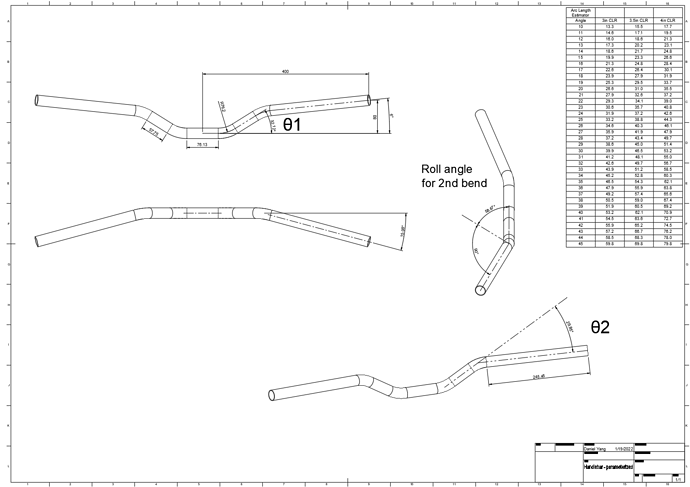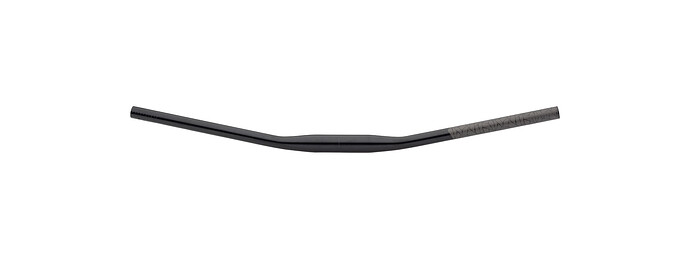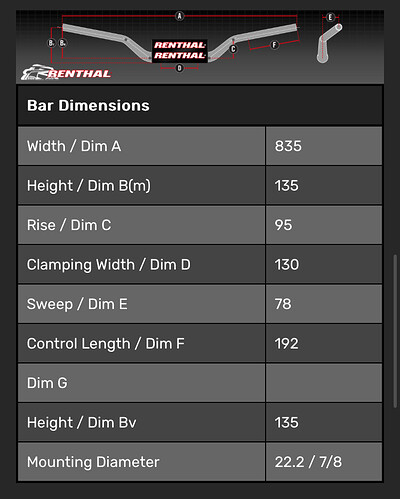Ok so:
I’ve been bending my own CS and SS since frame 0. Three bends, all in plane done on my hotrod vevor bender with aluminum follower dies and tube clamp. Bend quality is pretty ok, no ripples in .035 but a little flat on the outside.
I’ve made a few sets of bars now but it’s always a bit of a shot in the dark getting the bends phased correctly to get the stack/reach/sweep I want out of the bar.
So my question to you, the dark wizards of handlebar bending is this:
How do you properly phase the “rise” bend to the “sweep” bend?
Is there some dark math that explains this mystery?
Do I just buy a 20’ stick of mild steel and make a bunch of test bends and reverse my process from that?
This is really the last (perceived) piece of the puzzle for me designing bikes as a system.
1 Like
I don’t make bars, so I am only an internet expert. The challenge with compound bends is that they are nonlinear (do not add up). This means a 9deg back 5deg up is not 14degs.
You either get the bend and phasing angles through trial and error and a notebook, or CAD:
In this drawing, you start with a 32deg bend, followed by 59deg clock angle + 30deg bend. That yields a 80mm rise, 6deg upsweep, 15deg backsweep handlebar.
Don’t ask me how that works out. I don’t think there is a closed-form solution.
I’ll play around with it in cad and see if I can get where I want with it design wise.
I prescribe to the idea that upsweep isn’t really a thing and is actually a function of bar roll.
I’m sure some bending guru has a formula for this. Maybe I’ll do some digging in the automotive fab community and report back, the internet can be such a rabbit hole for this sort of thing.
1 Like
The upsweep and backsweep add up to form one angle. However, the up-and-back sweep sequence, combined with the bend locations, combine to place your grips in the correct place relative to the steerer tube.
That’s why those 16deg flat bars never feel the same as a riser:
1 Like
Ok yes but, if you were to have a “flat bar” with a single bend in it to create “sweep” and rolled it forward would that not create this so called upsweep? I understand that with a riser the phasing of the “rise” bend and the “sweep” bend work in conjunction to create upsweep but any bar can be rolled to have zero upsweep if I’m not mistaken.
1 Like
Not exactly - grip position will change in different ways with rotation of flat versus riser bars, risers generally give better real-world results (hence why everyone uses them). Stem and headset spacers are part of the equation.
Picture a side-on view centred on the stem clamp. A single-bend bar will always have the grip section pointed directly through the stem clamp. A riser bar - two bends in different planes - will have the grip section pointed elsewhere. But if you adjust stem length and headset spacers you can get the grips of each bar in the same location relative to the rest of the bike (different stem/spacer setups will be needed when you change the rotation of the bars though).
2 Likes
I agree with @JoeNation. Theoretically, you can get the same grip position as a riser with a flat bar with stem length and rise. In reality, you would need a 20mm longer stem with a goofy positive rise. That is why no one does it.
1 Like
I totally agree with what you are saying but I think you’re missing what I’m trying to get across. Given some sort of magical stem/spacer combo, a bar of the same width with a single bend or a riser bend should hypothetically be able to achieve the same hand position. I understand that in the real world this is usually very very hard to achieve.
I’ve just made a bike for my very short girlfriend with a very long front center.
We designed the bike as a system with its own fork and handlebars.
You could (and we did) get her hands in the correct place (based on our fit calculations) with about 100mm of spacers, a 30mm stem flipped behind the steer tube and a set of off the shelf bars.
From the get go the idea was to have custom bars to get the correct hand position.
This is getting pretty off topic but when talking about different bars we kind of need a datum for bar roll to reference so as to be able to compare the geometry and I, like many others, opt to use the “level” or zero upsweep position. This is extremely helpful when modeling and is actually how bars are described in bikecad with upsweep being a function of bar roll
Sorry, I didn’t mean to suggest there is a wrong way of doing it. I was just expressing that the whole upsweep, back sweep, rise, bar roll, stem length, spacers, etc… is a complex theoretical relationship that plays out weirdly in the real world.
Bike companies even define upsweep and backsweep differently.
PVD did some writing on this that you may find useful:
2 Likes
There are a few online stem calculators (usually java or something like it), where you input certain criteria and it allows you to compare two different set-ups. I couldn’t find anything similar that does bars, but it may exist.
The stem comparison tool you mention is a great one. Worth sharing. Shoutout to @jimg !
http://yojimg.net/bike/web_tools/stem.php
There isn’t really anything similar for handlebars because as @Daniel_Y mentioned the way handle bars are measured isn’t really standardised. Also the measuring and inputting of handler-bar data gets pretty complicated pretty quickly as I’m sure anyone who’s used the handlebar tool in BikeCAD can attest haha.
If only MTB bars were documents as well as Moto bars. Could CAD a bar in minutes off those kinda numbers.
2 Likes
hey @Daniel_Y don’t suppose you want to do up a very quick demo on drawing bars in fusion? I found the design a bike frame one you did beyond suoer useful. My cad skills are pretty basic at the best of times
Here is the CAD, if you download the drawing, you will get the 3D drawing, and you should be able to reverse engineer: Fusion
I will see if I have time to make a video later this week!
2 Likes
Thank you so much @Daniel_Y! I cant emphasize what a huge help you have been to my digital process, such an amazing resource to have in the community.
2 Likes
The key part I was missing is creating a construction plane through two edges to sketch my second bend
1 Like
Yup, that was the trick! Also, the second trick is realizing that 3D sketches are always really sketchy. I haven’t found a good way of doing them. But if it works, it works.
2 Likes


